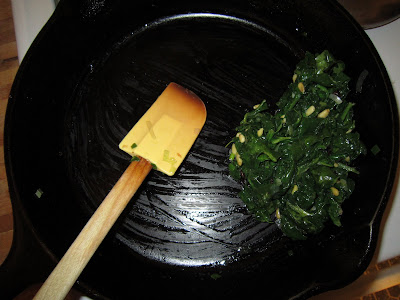
Pie is my very favorite dessert in the world. All that fruit feels virtuous, plus it's one of those rare foods that seems daunting but is easier than it appears. Lots of people have told me they couldn't make pie. I get it. All that stuff about "cutting in" and not letting gluten form in the crust probably sounds as mysterious to a lot of folks as "proofing yeast" and not overkneading bread dough sounded to me. But just like I managed to turn out a decent loaf of bread my first time, you can do the same with pie.

This is my grandma's pie crust recipe, and she made the best pies in the world. The secret is in the liquids: vinegar, unlike water, prevents gluten from forming when you work the dough (gluten makes the crust tough and chewy), and the egg keeps the crust from falling apart when you roll it out.

Grandma Frieda's Pie Crust
3 cups flour (unbleached, all-purpose, unsifted because I'm lazy)
1 teaspoon salt
1 1/4 cups butter (or, if you can find it, fresh lard)
1 egg
1 Tablespoon vinegar
up to 5 Tablespoons ice water
1. Mix flour and salt. Dice the butter into 1/2 inch cubes (this makes the next step easier and faster, which keeps the butter colder, which prevents gluten formation).
2. Cut in the butter. You can use a pastry cutter or two knives, but I prefer to use my hands, picking up handfuls of the mixture and rubbing it between my hands. You're finished when the mixture resembles small peas.
3. Beat the egg with the vinegar and mix in. Add water 1 Tablespoon at a time until you are able to form a ball with the dough.
Yields four 8 or 9 inch crusts (two double-crusted pies), or three 10 inch crusts.
Rhubarb Pie
Saran or other plastic wrap
2 10-inch pie crusts from recipe above
7 cups rhubarb, cut into 1-inch pieces
4 tablespoons cornstarch
1 to 1 1/2 cups sugar
pinch salt
milk or egg white
1. Pre-heat the oven to 450. Place Saran wrap on counter. Dust with flour. Place one crust over it, dust with flour, and roll out. Place in a 10-inch pie plate, preferably glass.
2. In a large bowl, mix rhubarb, cornstarch, sugar, and salt. Place in pie crust.
3. Roll out second crust. You can just place it on top and poke some vents in it, but I like to make a lattice crust. Using a butter knife, cut into 3/4 inch strips. Use two of the longest strips to make a cross in the center of the pie with the vertical strip on top. Add two more horizontal strips, top and bottom, above the vertical strip. Continue to work outward to the edges of the pie, folding the strips back as needed. Here's a video, in case, like me, you can't visualize anything spatial.
4. Brush the top crust with milk or egg white. This makes it shiny and pretty.
5. Bake 10 minutes at 450. Turn the oven down to 350 and bake an additional 50 to 55 minutes, until the crust is golden. Remove from oven and let cool at least 10-15 minutes before cutting. Best still warm from the oven, but good for breakfast too.

Since rhubarb season is long over and we are right in the heart of peach season, I suggest using them instead:
7 cups peaches, peeled and sliced.
1/4 to 1/2 cup sugar
1 teaspoon lemon juice
1/2 teaspoon cinnamon
1/4 teaspoon cardamom
1/8 teaspoon nutmeg
2 1/2 Tablespoons corn starch

Tune in next time to hear about the travails of trying to eat well in a non-air-conditioned apartment. Or, why I haven't been cooking much the last few months.




































